|
|
|
back and forth along San Cristobal
Monday, December 28 2015
location: off Punta Pitt, San Cristobal Island, Galapagos, Ecuador
During the night, the Letty sailed the length of San Cristobal Island (about 32 miles) and dropped anchor off Punta Pitt, the easternmost land in the Galapagos. The boat had rocked a bit in the night, but neither Gretchen and I experienced any serious seasickness. By now, many others on the boat were wearing patches behind their ears to slowly release anti-seasickness medications, though there were also seasickness pills available for the taking next to the snacks on the bar.
In an effort to wake us as early as possible, the crew of the Letty operate on Guayaquil Time (which is the same as Eastern Standard Time), and not Galapagos time (which is the same as Central Standard Time). This morning they woke us up at 7:00am Guayaquil Time, and us vegans convened at our table, the one in the dining room closest to the bow. I averted my eyes as I passed the huge bin of eggs on my way to fetch my coffee and toast, though I have to admit that bacon (which also was provided in a huge bin) still looks delicious, though I haven't eaten any in at least eight years.
This morning's activity involved a panga ride to the beach just northwest of Punta Pitt. There, we stashed our snorkeling gear and went for a hike up an occasionally-steep through scrubland to the red wastes above, some of which resembled the surface of Mars. Along the way, we passed a couple of black Smooth-billed Ani birds, which our guide James told us is an invasive pest that had been introduced by humans, probably for insect control. The anis have since developed the unwanted habit of killing baby Darwin Finches. For this reason, there is now a $1 bounty on anis, which are, according to James, customarily shot with pistols. [Later, on Floreana Island, Hernan would tell us that anis are never shot in the Galapagos, that instead eradicators destory their nests. This would be one of several occasions where James' wisdom would contradict Hernan's.]
Early in our walk, we came upon a big fluffy Red-footed Booby chick in a bush only a couple feet from the trail. It was utterly unconcerned by us. Most of the booby nests we would see, though, were visible from above, down in shallow steep-walled canyons near the ocean. There was also a partially-skeletonized booby in the path. Other fauna included Lava Lizards and some species of Darwin finch.
On the walk back towards the beach, me, my sister-in-law, and Ariana had a brief conversation with James about matters that can and cannot be brought up by guides. One of us asked a question that caused James to say that there are some topics that guides are never to bring up, including politics, religion, and evolution. Apparently there are enough creationists visiting the Galapagos for this to be an issue. Once we, the visitors, bring it up, then they can discuss it. But they are never to initiate a discourse on evolution. At that point I joked about Noah getting all the right finches to the right islands, and it was pretty clear after that that evolution was going to be a safe topic within our group.
Gretchen decided during this walk that the three Greek kids were awesome. Cloe was expressing real interest in veganism and animal rights issues, and young Peter! was overheard asking great questions of our guide James. And there was something about Alexandra's self-aware adolescent detachment that resonated with similar inclinations in Gretchen.
I did a little snorkeling off the beach, cutting my finger on the first rock I grabbed. But the visibility wasn't great, so I soon returned to shore and walked over to the west end of the beach to see what the ongoing human commotion was about. There I found Gretchen and some of the others standing around marveling at a baby sea lion. It wasn't the smallest baby sea lion in the world, but it was the first. And it lay on a waist-high sandblasted pedestal. Eventually I picked my way through the rocky surf around a lava formation to a cove that was full of sea lions (0.708870S, 89.253205W). They were coming, going, lounging on the rocks, and looking at me curiously. Then I noticed one had a piece of blue rope cutting into its neck all the way around, and this one seemed to be gazing at me particularly beseechingly. Evidently the rope had gotten stuck there a long time ago and was becoming part of the animal, though in a way that was not likely to end well. It looked like a slowly-unfolding tragedy to me, since I couldn't imagine that the Galapagos park people would have any way to deal with it (and would probably consider doing anything on behalf of a specific sea lion a low priority). I almost didn't tell Gretchen about it, because I know how much animal tragedies affect her. But when I did, she immediately told James and Hernan, and they reassured her that they'd be calling it in to the park authorities, who would be sending some guys out to free the poor little guy. The story they told Gretchen is that if an animal is suffering from a human-inflicted problem, measures will be taken to reverse the affliction. If, however, an animal is suffering from natural trauma such as starvation or a shark bite, well, that's the way of nature, and Darwinian forces must be free to operate in this, the land of their discovery. It's possible that they just told Gretchen this to make her feel better. [But if so, it's curious that, days later on another island, James brought up the incident and the resulting call he'd made about it to headquarters.]
After lunch, the Letty was sailing for the Sleeping Lion formation halfway down the long northwest side of San Cristobal. Along the way, I was up on the sunroof tinkering with my Arduino Nano and LCD display. Yesterday, I'd run into trouble compiling code using the LiquidCrystal_I2C library, but had managed to hack together an imperfect solution. By commenting out the home() method in that library, the code would compile, though for some reason it wouldn't allow me to print more than one character to the LCD per print() command. If I'd had the internet, I could have found a solution, but with my laptop isolated from the internet by a massive air gap over the Pacific, I was forced to improvise with just my problem-solving skills. Don't get me wrong, such problem-solving is fun for me, even if it is always in danger of being dashed on the rocks of frustration. I definitely experienced a measure of that when the function I wrote to print whole sentences on the LCD started crashing the compiler just like the home() method had. There was something fundamentally wrong with my Arduino setup, and it was bigger than my LiquidCrystal_I2C library issue.
As you might imagine, my tinkering with electronics up on the sun deck did not go completely unnoticed. As you might recall from this summer's vacation at the inlaws' cabin in the Maryland mountains, my young niece harbors a gender-inappropriate interest in engineering and showed unexpected interest in my weatherstation client when I was working on its code offline in the cabin. She was the first to run over to check out what I was doing today, but she didn't stay long, perhaps because I wasn't actually making anything too interesting happen. The person who stuck around the longest was young Peter!, whose wild imagination soon had him whimsically describing the purpose of the components on the Arduino Nano and LCD boards. He'd point out the round black drivers on the LCD circuit board and, lacking the necessary jargon, use various rocket ship sound effects in their place. But he also wanted to know stuff, such as what were the purposes of strands in the rainbow ribbon cable I'd used to make an I2C connection between the two boards, and why hadn't I used all five of the wires. There is a lot to know before one can begin to understand even such seemingly-simple digital electronics, and even most adults don't have a chance of explaining it without reference to magic. But I did what I could, saying the red wire carried the positive power, the black carried the negative, and that the two other wires carried all the necessary information to draw stuff on the screen. Peter! wanted me to make the LCD display the message "I am a cat meow!" so I dutifully wrote the code to do so, which (due to my problems with this particular Arduino setup), required me to make a separate print statement for each individual character. Writing the code to do this doesn't sound like much, but it's a little mind-blowing for a kid to see something being done on a computer being faithfully reproduced on a separate mysterious display attached only by a ribbon of rainbow colors. I then turned over the laptop to Peter! so he could "hack" my code to make the display show a different message. Since his new message required more characters, he had to cut and paste existing lines and edit them, making sure each line ended with a semicolon. This sort of grunt work makes up about 10% of what I do as a computer professional.
Meanwhile, Peter!'s father Jeff sat nearby, and he kept telling Peter! to leave me alone, that I was busy and that he should find something else to do. But I insisted that it was alright, that I like teaching kids about computers. I added that Peter! was learning a valuable skill and could now put "C programming" on his resume. Eventually Andrea (who, remember, is a man my age) came over and had a go at hacking the code to display a different message, and for a moment there was actually a tug-of-war over the laptop. But at least it didn't end up in the ocean.
I should mention that when the kids first saw my laptop, which is a boxy black Compaq 2510p ultraportable, they asked if it was an "old-fashioned" computer. While it is an older computer, dating to 2007, it nevertheless resembles business computers that are being made to this day. What these kids meant by "old fashioned" was actually "non-Apple." Most upper-middleclass American families use exclusively Apple equipment, which these days tends to be silvery and very thin. A black computer with square corners and lots of seams, vents, and ports looks like technology that they have a vague awareness of, but don't see on a regular basis. Thus they make the assumption that it is old.
This afternoon, our guides took on us on a panga ride along the coast of San Cristobal within view of the spectacular split island of the Sleeping Lion jutting 500 feet vertically from the ocean. There wasn't much to see here except old lava flows that had been eroded in interesting ways: here an archway, there a cave, there a natural bridge. Our guides had brought us here mostly so we could snap pictures, especially ones that framed the distant rocks of Sleeping Lion with the natural architecture immediately around us.
Eventually we landed on a nearby beach called Cerro Brujo (0.766162S, 89.457857W), which our guides had billed has having been voted one of the best on Planet Earth (and probably in the entire solar system). We could snorkle from it if we wanted, but by now I was wise to the whole beach snorkeling phenomenon, so if I did that, it wasn't for long. It seemed better to just walk a length of the fabulous beach, which was long and featured white sand that wasn't hot under the tropical sun. Most of the time there on Cerro Brujo was spent fussing over the several baby sea lions present, one of which being only a few days old. Of the kids, Alexandra seemed to be the most into the baby sea lions, agreeing with Gretchen that it was "so unfair" that they were this cute and couldn't be touched, eventually adding "I'm angry" to this declaration, which they both repeated incessantly in the face of the cuteness. [Gretchen and Alexandra would go on to say this so often that severely-blond Emily would start saying it too.] Though Alexandra was the most adult-looking of all the kids, there was something about the way she moved that was still decidedly childlike. On several occasions, for example, I saw her running from one place to another with both arms up in the air, something no adult would do (unless being pursued by a cloud of White-faced Hornets).
Further south along Cerro Brujo, I came upon a couple mid-sized Marine Iguanas that had hauled themselves out onto the sand like small reptilian sea lions. These were the first marine iguanas I'd seen on this vacation. Walking up and down the beach, I spooked a number of Ghost Crabs (the cause of all the holes in the sand), which skittered sideways across the sand with supernatural speed.
When our time on the beach ended, our guides led us through some narrow fissures in the lava to a small beach we hadn't yet visited. This proved to be a rather serious obstacle course for some of the older people in our group, but despite grumbling, everyone made it to the pangas okay.
From Cerro Brujo, the Letty sailed back to the soutwest end of San Cristobal to pick up some last-minute supplies from the harbor where our adventure had started. We would spend a second night there, which was a little disappointing, as I'd been hoping to spend the night far from artificial lights, where there might have been a chance of seeing some celestial spectacles of the southern hemisphere.
The Letty can sail much faster than the Golondrina could ten years ago, and perhaps this is why it attracted a flock of wandering Frigate Birds, all of whom decided they were going the same way we were. They seemed to be pulled along in the atmospheric wake that our boat generated, never needing to flap their wings. One of them (which, judging by its color, was a juvenile) made it even easier on herself by simply perching on an antenna mast.
This evening, up on the sun deck, I got caught up in a conversation that began with expressions of wonder at the glory of all the stars visible overhead. Jeff was saying that it didn't make any sense that there would be no other life in the Universe outside of Earth, and his view on this seemed to be (somewhat confusing) an outgrown of his religious beliefs (he is Greek Orthodox). My view was that we simply don't know what the chances are for life to appear, and that it's entirely possible that we're the only ones. But I assured Jeff that, given the lack of information, his view is equally valid. At this point he seemed to confuse the chances for life with the chances for intelligent life, and by then I'd brought in the Anthropic Principle, which (in this context) says that it doesn't matter how unlikely intelligent life is to appear, it still has to have appeared in order for us to be talking about it. At this point Josh (the Bar Mitzvah kid) observed, "I hate philosophy."
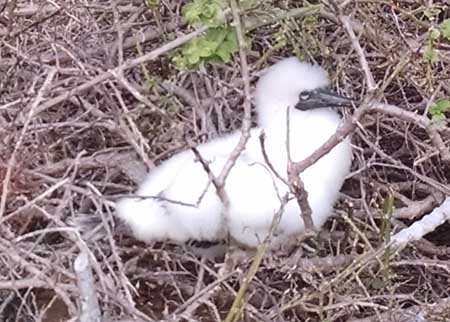
A baby Red-footed Booby in a bush without a nest alongside the trail where it begins at the beach.
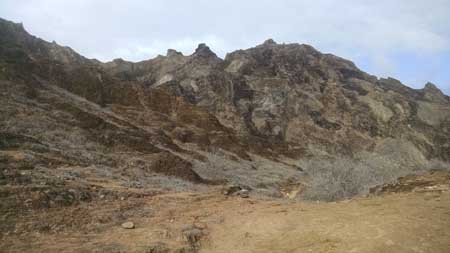
The Mars-like terrain adjacent to Punta Pitt. Click to enlarge.
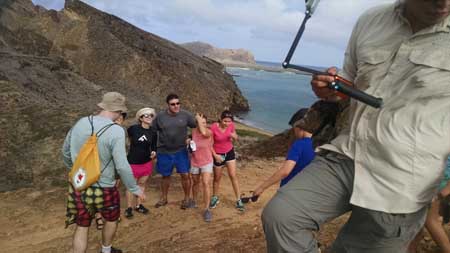
Posting at Punta Pitt, with a view to the northeast.
Click to enlarge.
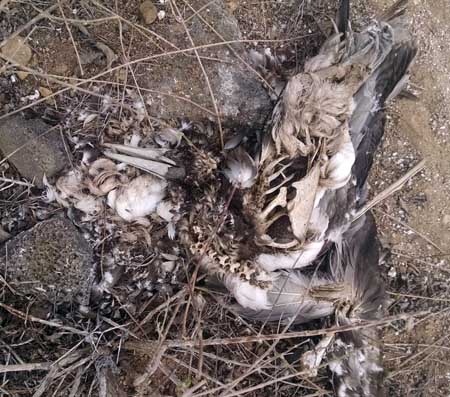
A dead Red-footed Booby at Punta Pitt.
Click to enlarge.
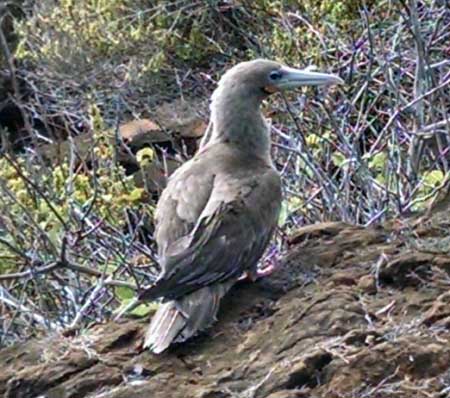
An adult Red-footed Booby at Punta Pitt.
Click to enlarge.
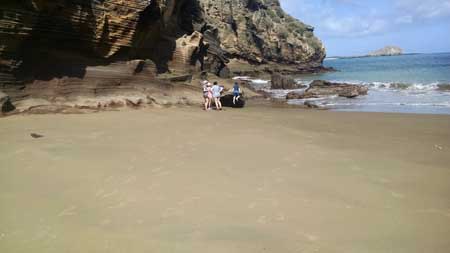
What's that commotion on the beach northeast of Punta Pitt?
Click to enlarge.
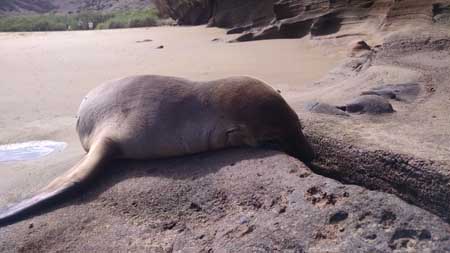
Oh, it's the trip's first baby sea lion.
Click to enlarge.
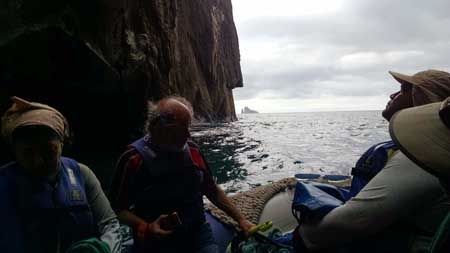
My mother-in-law and father-in-law, the 500-feet-tall Sleeping Lion in the background, and our panga driver.
Click to enlarge.
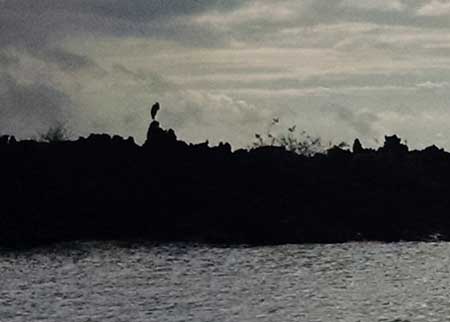
A heron is just another odd feature on the rough lava at the north end of Cerro Brujo.
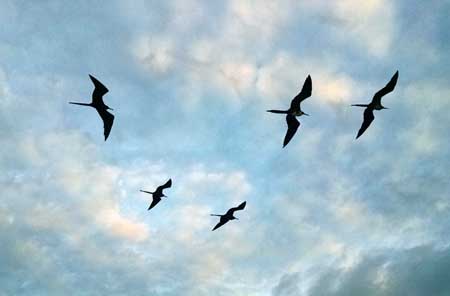
Click to enlarge.
For linking purposes this article's URL is:
http://asecular.com/blog.php?151228 feedback
previous | next |









